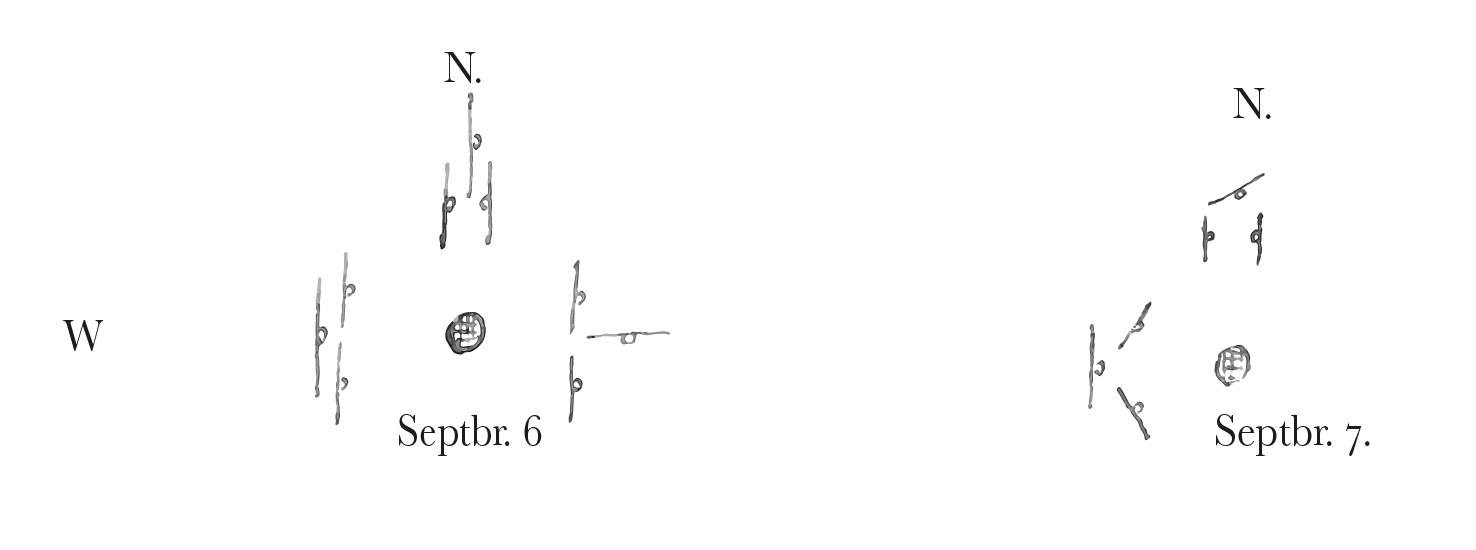From Fritz Müller 6, 7, and 9 September 1881
Blumenau, St. Catharina, | Brazil.
Septbr. 6. 1881.
My dear Sir.
I can now inform you that the leaves of Schizolobium are protected by a waxy secretion.1
The differences occurring in the nyctitropic movements of leaves appear to be quite inexhaustible. One of the most curious cases and which has utterly puzzled me for some days, is that of Crotalaria cajanæfolia. The leaves are trifoliate and the leaflets, instead of rising, as they do in the species mentioned in your “Movements of Plants”, move downwards at night, and at the same time one or two or all of them rotate.2 In some leaves the lateral leaflets sink downwards without rotating, whereas the terminal one rotates 90o either to the right or to the left. In other leaves the lateral leaflets rotate 90o, so that their upper surface is turned either away from the stem or towards the stem, the terminal leaflet either moving downwards without twisting or rotating also.
Other combinations may be seen and in young plants, with 6 or 8 leaves, every leaf may sleep in a peculiar position. I tried in vain to find some clue to this apparent capriciousness, till one day at sunset I saw the terminal leaflets of the first trifoliate leaves of a young Centrosema (different from the species mentioned in your book) turning their upper surface towards the setting sun and remain in this position till late in the evening (and probably the whole night).3 This suggested the idea that in Crotalaria cajanæfolia also the nyctitropic movements might be influenced by the setting sun and indeed so it is.— The leaflets turn their upper sides towards the setting sun if they can do so without rotating more than 90o.— Thus for instance on the western side of the stem the terminal leaflet sinks downwards without twisting, whereas the lateral ones rotate 90o, turning their upper sides away from the stem; on the eastern side, on the contrary, the upper sides of the lateral leaflets will face the stem. On the southern or northern side the lateral leaflets move downwards without twisting, whilst the terminal one rotates turning westwards its upper side. Thus at night this plant may even serve as a compass.— I shall send to “Kosmos” a short notice on this plant.—4

Septbr. 7.
For some weeks we had had a cloudless sky and I was very curious to know, how our Crotalaria would behave, when not illuminated during the day by the rays of the sun. At length to day the sky was covered by dense clouds the whole day; about an hour after sunset all the leaflets were as yet in a nearly horizontal position or had scarcely begun to move downwards.— Now, about three hours after sunset most of them continue to be nearly horizontal in two plants, whereas in eight plants they have moved downwards so as to be nearly or quite perpendicular, and at the same time, they have rotated in the same direction, as if they had been illuminated by the setting sun, but in a far lesser degree. In some leaves on the western side of the plants the lateral leaflets have rotated little more than 45o (instead of 90o), and the terminal leaflets of some leaves placed on the northern or southern sides have rotated scarcely 30o.—
The nyctitropic movements of the above mentioned Centrosema have been quite the same as in the previous cloudless days.— No human eye would have been able to distinguish, where the sun was sinking beneath the horizon, whereas the terminal leaflets of Centrosema turned their upper sides exactly to that part of the heaven. Was it, because they had done so for many previous days, or because, even with the sky densely covered with clouds, they received more light from the West, than from the East?—
—Septbr. 9. Yesterday I covered two plants of Crotalaria from above, as well as from the western, southern and northern sides, so that they received light only from the East. The day was rather cloudy, as it was to day also. Yesterday the leaflets slept in the usual way, just as they did on the plants, which had remained uncovered. To day this is also the case with almost all the leaves; only the uppermost (youngest) leaf in either plant behaves differently; this leaf (in either plant) is on the western side of the stem and the upper side of the lateral leaflets is turned eastwards, instead of westwards, as they are in older leaves of these very same plants, and in all the leaves of the uncovered plants. Thus the feeble illumination from the East has not altered the inveterated movement of the older leaves, while it has caused the leaflets of the youngest leaf, to rotate eastwards.— It might perhaps be worth while to try some more experiments on this Crotalaria.—
With the highest respect I am, dear Sir, | yours very faithfully Fritz Müller.
Footnotes
Bibliography
Movement in plants: The power of movement in plants. By Charles Darwin. Assisted by Francis Darwin. London: John Murray. 1880.
Müller, Fritz. 1881f. Eine Pflanze, welche bei Nacht die Himmelsgegenden anzeigt. Kosmos 10: 212–14.
Summary
Discusses some of his observations on the sleep movement in plants. Has been studying the leaflets of Crotalaria; has discovered they move to face the setting sun.
Letter details
- Letter no.
- DCP-LETT-13318
- From
- Johann Friedrich Theodor (Fritz) Müller
- To
- Charles Robert Darwin
- Sent from
- Santa Catharina, Brazil
- Source of text
- DAR 171: 287
- Physical description
- ALS 4pp
Please cite as
Darwin Correspondence Project, “Letter no. 13318,” accessed on 24 April 2024, https://www.darwinproject.ac.uk/letter/?docId=letters/DCP-LETT-13318.xml


